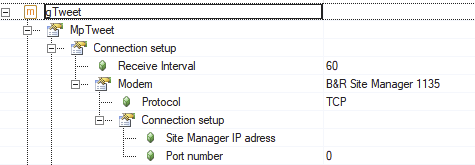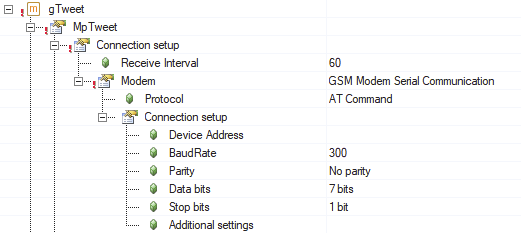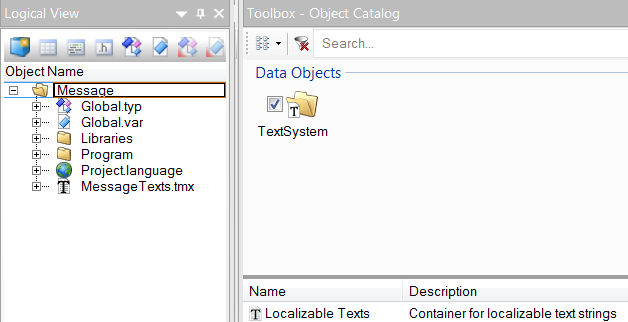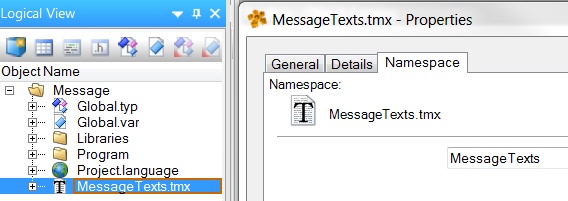mapp Services V5.16
For information about how the configuration can be adjusted at runtime, see here in section "Changing the configuration at runtime".
•Show advanced parameter
Name |
||||||||||
MpTweet |
||||||||||
Connection setup |
||||||||||
Receive Interval |
||||||||||
Modem |
||||||||||
Protocol |
||||||||||
Connection setup |
||||||||||
Site Manager IP adress |
||||||||||
Port number |
||||||||||
Protocol |
||||||||||
Connection setup |
||||||||||
Device Address |
||||||||||
BaudRate |
||||||||||
Parity |
||||||||||
Data bits |
||||||||||
Stop bits |
||||||||||
Additional settings |
||||||||||
Receiver List |
||||||||||
Receiver: {/Name} |
||||||||||
Name |
||||||||||
Phone Number |
||||||||||
User Language |
||||||||||
Message List |
||||||||||
Message: {/Name} |
||||||||||
Name |
||||||||||
Text |
||||||||||
Subscriptions and hierarchy |
||||||||||
Alarm Message Subscribers |
||||||||||
Receiver: {/Name} |
||||||||||
Name |
||||||||||
Type |
||||||||||
Expected Response |
||||||||||
Response Timeout |
||||||||||
Attempts |
||||||||||
Requests |
||||||||||
Request: {/Request ID} |
||||||||||
Request ID |
||||||||||
Type |
||||||||||
Request Message |
||||||||||
Return Message |
||||||||||
Audit Trail |
||||||||||
Record sending |
||||||||||
Record receiving |
||||||||||
Message text snippets |
||||||||||
Snippet: {/Key} |
||||||||||
Key |
||||||||||
Value |
||||||||||
Process Variable |
||||||||||
Connection setup
Section "Connection setup" defines the way that messages should be sent. B&R SiteManager or another modem can be used. For additional information, see section Basic concept.
B&R SiteManager
When selecting B&R SiteManager, the connection parameters to SiteManager must be defined. 26864 must be defined as the port number. "TCP" must be used as the protocol. Option "UDP" is reserved for later use. The "receive interval" is specified in seconds and determines how frequently MpTweet queries the modem for information such as whether there are requests pending.

Other modems
When selecting "GSM modem serial communication", the connection parameters of the desired modem are specified. For additional information, see here.

Recipient
All possible recipients are listed under "Receiver List". The name, telephone number and language are specified for each recipient. The name uniquely identifies the recipient within the application. The telephone number can be used to reach the recipient.
The telephone number can be entered in various formats. The following formats are supported:
•Country calling code: The country calling code can be indicated by the character "+" or 00: +43, 0043.
•Spaces: The telephone number can be specified with or without spaces: +43676821257963, +43 676 821 257 963.
•Other characters: The telephone number can also include other the characters "-" and "/": +43 676 58058-0, +43 676/580580.
"User Language" defines the language in which the message should be sent.

For more information on how to send a message in different languages, see "Messages".
Messages
Messages that the machine should send should are listed under "Message List". For each message, a name and a message text must be entered. Parameter "Name" uniquely identifies the message in the application. It is specified under parameter "Message" of function MpTweetSendMessage, for example. "Text" contains the message to be sent. The message text can be specified in two different ways:
•Message text directly in the configuration: The message text is entered in the configuration under "Text". If you do this, only one language is possible.

•Message text localized using the text system: The Automation Studio text system is used to localize message texts. In this case, the text is not specified directly in the configuration, but referenced via the text system.

A file containing the message texts must first be added in the Logical View. This file contains versions of the message texts in each project language. The connection is established via the namespace of the text and the text ID. The namespace can be defined in the properties for the file containing the texts. The text ID is then defined for each text in the file to be localized. The namespace and text ID are specified inside curly brackets. The connection to the text system is established with the $ character: {Namespace/TextID}.
Fig.: Use of text system |
Fig.: Project languages |
Fig.: Namespace localizable text file |
Fig.: Text ID and localized texts |
Depending on the modem used, it is important to note which characters are supported. For more information, see here.
Messaging hierarchy
It is possible to define a messaging hierarchy. This is done under "Subscriptions and hierarchy". The order specified here is used to establish a hierarchy for sending alarm notifications. The name of an existing recipient and the type of subscription are specified. The type of subscription defines whether the recipient simply receives the messages ("Receive only") or if they should be required to confirm receipt ("Confirmation of receipt"). If the alarm is no longer active or has already been acknowledged, the specified recipients will still be informed of the alarm.
If the specified recipient is expected to provide confirmation, then the expected response must be specified under "Expected Response". "Response Timeout" specifies the how long to wait for a response/confirmation from the recipient. Under "Attempts" it is possible to define how many times the alarm message should be resent to the same recipient after the "Response Timeout" has expired. If the recipient fails to respond after the defined number of attempts, then the alarm message is forwarded to the next recipient in the list.
Requests
Requests to MpTweet are defined using "Requests". Requests can include things like querying the current status of the machine or transmitting a command. An example of how a request can be implemented in a specific application is illustrated in the use case Sending a machine command.
The following parameters are specified:
•Request ID: The "RequestID" uniquely identifies the request within the application.
•Type: Specifies whether the request is a status query or a command.
•Request Message: Message text that must be sent in order to receive the corresponding information. If a request is sent to MpTweet, then the message text must exactly match the text specified here. This includes case sensitivity (lowercase and uppercase letters)!
•Return message: Response message that is returned to the sender. It may contain the current status of the machine or notification that a command was executed successfully.
Message text snippets
You can use message text snippets to integrate application data into your message texts.
This is where all text snippets are defined that are to be used for the different messages. A single text snippet can be used for one or more messages. A key is defined for each text snippet that is used to identify the text snippet in the message text. The PV that supplies the application data is also defined.
In our example, the current temperature should be integrated in the message text for the request "ActTemp". This could look like this:

The text snippet still needs to be incorporated in the message text.

Message text snippets can be incorporated in the message text regardless of whether the text comes from the message configuration or is read from the text system.
The syntax looks the same in both cases:
{&Key}
The & character inside the curly brackets indicates a text snippet. The corresponding Key then follows the & character.
The following data types can be integrated into the text using a snippet:
•BOOL
•SINT
•INT
•DINT
•USINT
•UINT
•UDINT
•REAL
•LREAL
•STRING
•WSTRING



